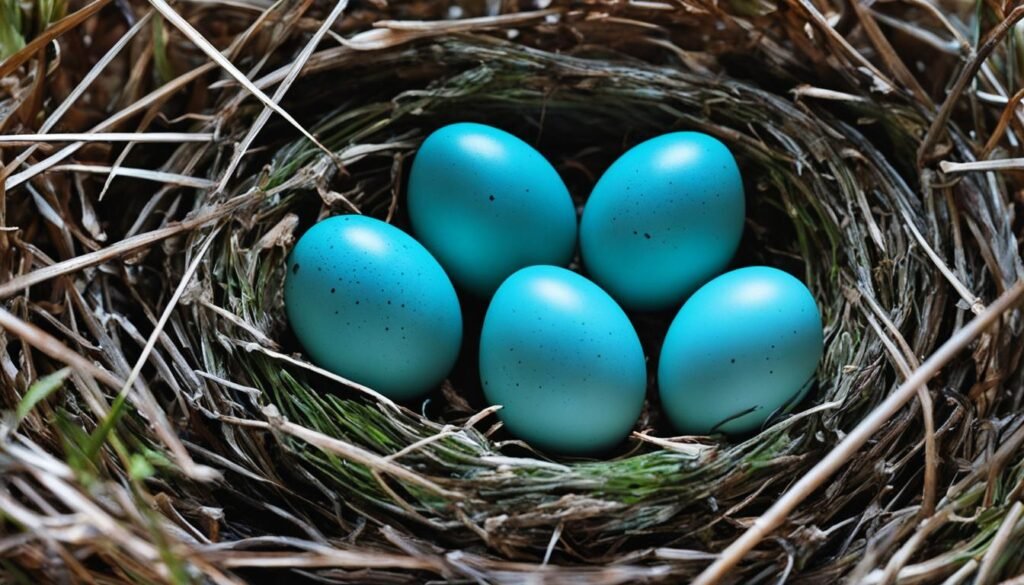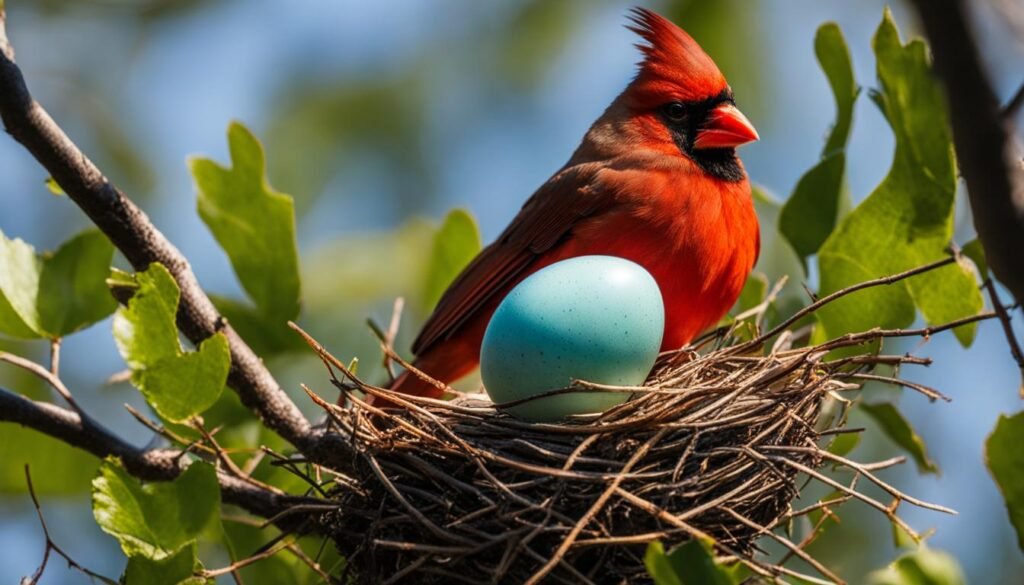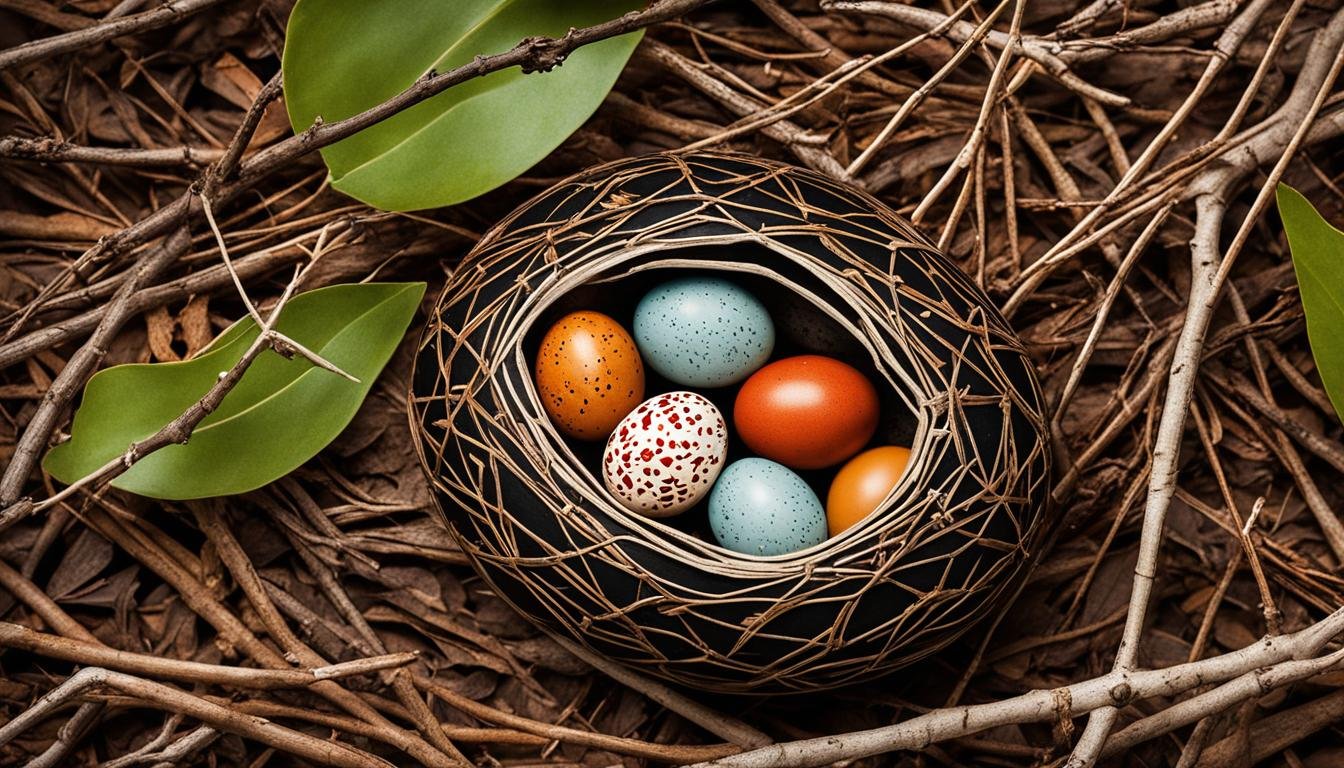When it comes to the wonders of nature, cardinal eggs are truly captivating. These small, exquisite eggs are easily recognizable by their glossy surface and a range of colors, from white to pale green, adorned with speckles of brown, purple, or gray. As a nature enthusiast, I have always been fascinated by the nesting habits, unique patterns, and reproductive behaviors of these beautiful birds.
Key Takeaways:
- Cardinal eggs display distinctive patterns and colors, adding visual interest to their shells.
- Female cardinals lay 2-5 eggs per clutch and carefully incubate them for 11-13 days.
- Cardinals are skilled nest builders, constructing cup-shaped nests hidden in shrubs or dense vegetation.
- The incubation period is crucial for the healthy development of the embryos inside the eggs.
- Attract cardinals to your backyard by creating a suitable habitat with native plants and bird feeders.
Recognizing Cardinal Eggs by Size and Surface
Cardinal eggs are truly unique in their size and surface characteristics. Measuring between 0.9 to 1.1 inches in length and 0.6 to 0.8 inches in width, these eggs have a distinct appearance. Their glossy surface serves as a protective barrier, maintaining optimal moisture levels for the developing embryos.
The color of cardinal eggshells can vary, ranging from white to cream, and sometimes even displaying a delicate pale green hue. These subtle variations make it easier to identify cardinal eggs in nature. Their distinctive size and glossy surface, combined with the range of shell colors, create a captivating sight in bird nests.
Recognizing cardinal eggs by their size and surface allows us to appreciate the intricacies of avian reproduction and the remarkable diversity found in nature. To provide you with a visual of the unique characteristics of cardinal eggs, take a look at the image below:
Understanding Cardinal Egg Patterns and Colors
Cardinal eggs are not only known for their unique size and surface, but also for their distinctive patterns and colors. The patterns on the eggshell add visual interest and serve as a form of camouflage, blending the eggs into their surroundings for protection. The markings on cardinal eggs can vary in density and color, showcasing shades of brown, purple, or gray. Each egg is truly a work of art, adorned with speckles, dots, and streaks that create a mesmerizing mosaic on the surface. Furthermore, the base color of cardinal eggs is typically white or cream, with some eggs even displaying a gentle pale green hue. The combination of these intricate patterns and colors makes cardinal eggs a fascinating sight to behold.
Camouflage and Beauty Combined
“The speckles, dots, and streaks on cardinal eggshells not only make them visually captivating, but also help them blend into their environment. It’s a stunning combination of camouflage and beauty.”
Exploring Cardinal Nesting Habits
Cardinals are remarkable nest builders, demonstrating their skill and ingenuity in constructing secure homes for their eggs. These nests, typically cup-shaped, are meticulously crafted using a variety of natural materials such as twigs, grasses, and plants. Cardinals pay great attention to detail, ensuring the stability and durability of their nests.
The construction process involves the careful layering of materials, creating a sturdy foundation for the eggs. Cardinals begin by layering coarse twigs, forming the base of the nest. This provides a strong structure, ensuring stability and protection from external elements. They then proceed to construct a leafy mat above the twig layer, adding an extra layer of insulation and cushioning for the eggs.
One of the unique features of cardinal nests is the use of grape-vine bark. Cardinals incorporate this material into their nests’ third layer, providing additional strength, structure, and flexibility. Finally, they complete the nest with a layer of fine materials, such as grass and plant fibers, creating a soft and cozy interior for their precious eggs.
Cardinals are selective when it comes to choosing the location of their nests. They often opt for hidden spots within shrubs or dense vegetation, strategically placing their nests to deter predators and ensure the safety of their eggs. This instinctive behavior demonstrates the cardinal’s commitment to protecting their offspring and ensuring their survival.
During the nesting period, the female cardinal takes on the primary responsibility of caring for the eggs. She diligently incubates them, providing warmth and stability to create an optimal environment for their development. Meanwhile, the male cardinal supports the female by foraging for food, ensuring a continuous supply of sustenance during the incubation period.
This image showcases a cardinal nest, a masterpiece of avian engineering, nestled amidst the beauty of nature. The intricate design and attention to detail exhibited by cardinals in their nesting habits are truly remarkable. It is a testament to their instinct and dedication in creating a nurturing environment for their offspring.
Understanding the Incubation Period of Cardinal Eggs
Cardinal eggs are a fascinating part of their reproductive process. These tiny treasures undergo an incubation period of 11-13 days, diligently cared for by the female cardinal. During this time, she provides warmth and protection to the eggs, ensuring the healthy development of the embryos inside. It’s a crucial phase that sets the stage for the successful hatching of cardinal chicks.
Incubation is a delicate process where temperature and humidity levels play a vital role. The female cardinal uses her body heat to keep the eggs warm, maintaining an optimal environment for embryonic growth. This remarkable act of nurturing illustrates the dedication and instinctual care that cardinals exhibit.

Throughout the incubation period, the female cardinal rarely leaves the nest, only venturing out briefly for food and water. She carefully regulates the temperature of the eggs by adjusting her position, ensuring that they receive the perfect amount of heat. This attentive behavior guarantees the proper development and growth of the cardinal chicks inside the eggs.
The incubation period also serves as a protective measure. By incubating the eggs, the female cardinal reduces the risk of predation. Her constant presence deters potential predators, safeguarding the fragile eggs and increasing the chances of successful hatching.
The incubation period of cardinal eggs is a testament to the remarkable reproductive strategies of these birds. It showcases the unique bond between the female cardinal and her unborn offspring. As the days pass, the anticipation grows, leading to the exciting moment when the eggs hatch, revealing the new generation of vibrant red cardinals.
Exploring Cardinal Bird Reproduction
Cardinals have a unique reproductive behavior. Female cardinals typically lay 2-5 eggs per clutch, with the exact number depending on various factors. Cardinals may lay up to three clutches of eggs in a single breeding season, increasing the chances of successful offspring. The male and female cardinals both participate in feeding and caring for the young, ensuring their healthy growth. This reproductive behavior contributes to the population of cardinals and the continuation of their species.
When it comes to cardinal bird reproduction, the process is fascinating. Female cardinals carefully select a suitable nesting site to build their nests and lay their eggs. They invest a great deal of energy and effort in providing the best environment for their eggs to hatch successfully.
“Cardinals are known for their dedication to their young. Both parents take an active role in the care and feeding of the nestlings. This teamwork ensures the healthy growth and development of the cardinal chicks.”
The male cardinal plays an essential role in cardinal bird reproduction. He assists in the incubation process, taking turns with the female to keep the eggs warm and protected. This collaborative effort fosters a strong bond between the male and female cardinals and ensures the survival of their offspring.
Cardinals display remarkable resiliency in their breeding habits. They have adapted to thrive in various habitats, including urban areas, making them a common sight for bird enthusiasts across the United States. By understanding and appreciating their unique reproductive behaviors, we can contribute to the conservation efforts and help sustain the population of these beautiful birds for future generations to enjoy.
Stay tuned for the next section, where we will dive deeper into the care and vulnerabilities of cardinal eggs.
Understanding Cardinal Egg Care and Vulnerabilities
Cardinal eggs are precious and delicate. They face numerous challenges in the wild, including the ever-present threat of predators. Animals such as snakes, raccoons, squirrels, and even other birds are known to prey on cardinal eggs. To protect their offspring, female cardinals take extraordinary measures.
Hidden in hidden locations, cardinal nests are carefully constructed and hidden to provide camouflage and minimize the risk of discovery. The mother cardinal relies on her natural ability to blend in with her surroundings, ensuring the safety of her precious eggs.
The incubation period is a critical time for the survival of the eggs. During this period, both the male and the female cardinals take turns incubating the eggs, providing warmth and protection. The parents diligently care for the eggs, ensuring that they receive the optimal conditions needed for healthy development.

The collective effort of the cardinal parents underscores the importance they place on their eggs. Their dedication and commitment demonstrate the lengths they go to ensure a successful hatching and the healthy development of their nestlings.
Attracting Cardinals to Backyard Habitats
To attract cardinals to your backyard, it’s important to create a suitable habitat. Cardinals are drawn to areas with dense vegetation, so planting native trees, shrubs, and flowers can provide shelter, nesting sites, and a food source.
Additionally, offering bird feeders with sunflower seeds, safflower seeds, and birdseed can attract cardinals and provide them with supplementary nutrition. Cardinals are known to frequent feeders that offer their favorite seeds.
Creating a welcoming environment with an ample supply of food and cover will increase the likelihood of cardinals nesting in your backyard and returning year after year. Observing these striking birds in their natural habitat will undoubtedly bring joy and beauty to your outdoor space.
Conclusion
Cardinal eggs are a beautiful wonder of nature. Their small size, glossy surface, and a range of colors make them easily recognizable. Understanding the unique characteristics of cardinal eggs, such as their size, surface, patterns, and colors, deepens our appreciation for these vibrant red birds.
By delving into the nesting habits and reproductive behaviors of cardinals, we gain insight into their dedication and instinct to ensure the safety and survival of their offspring. Female cardinals diligently care for their eggs during the incubation period, while the males provide food support.
To preserve these stunning creatures for future generations to admire, it is important to create a suitable backyard habitat and practice conservation efforts. Planting native trees, shrubs, and flowers, as well as providing bird feeders with suitable seeds, can attract and support cardinals in our own environments. By doing so, we contribute to the continued reproduction and population of these remarkable birds.
FAQ
What do cardinal eggs look like?
Cardinal eggs are small in size, with a glossy surface. They come in a range of colors from white to pale green, adorned with speckles of brown, purple, or gray.
How big are cardinal eggs?
Cardinal eggs measure between 0.9 to 1.1 inches in length and 0.6 to 0.8 inches in width.
How are cardinal eggs patterned and colored?
Cardinal eggs have distinctive patterns and colors. The shell is speckled with marks that can vary in density and color, including shades of brown, purple, or gray. The base color of the eggs is typically white or cream, sometimes with a pale green hue.
Where do cardinals build their nests?
Cardinals build cup-shaped nests using twigs, grasses, and plants. They often choose hidden locations in shrubs or dense vegetation to protect their nests from predators.
How long do cardinal eggs incubate?
Cardinal eggs incubate for 11-13 days. During this time, the female cardinal diligently tends to the eggs, providing warmth and protection.
How many eggs do female cardinals lay?
Female cardinals typically lay 2-5 eggs per clutch. They may lay up to three clutches of eggs in a single breeding season.
How do cardinals care for their eggs?
Female cardinals incubate the eggs, while the male provides food during the incubation period. The nesting habits and parental care of both male and female cardinals ensure the successful hatching of the eggs and the healthy growth of the nestlings.
What are the vulnerabilities of cardinal eggs?
Cardinal eggs are vulnerable to predation by animals such as snakes, raccoons, squirrels, and other birds. Female cardinals hide their nests in hidden locations and rely on camouflage to protect their eggs from predators.
How can I attract cardinals to my backyard?
To attract cardinals to your backyard, create a suitable habitat by planting native trees, shrubs, and flowers. Offering bird feeders with sunflower seeds, safflower seeds, and birdseed can also attract cardinals and provide them with supplementary nutrition.
